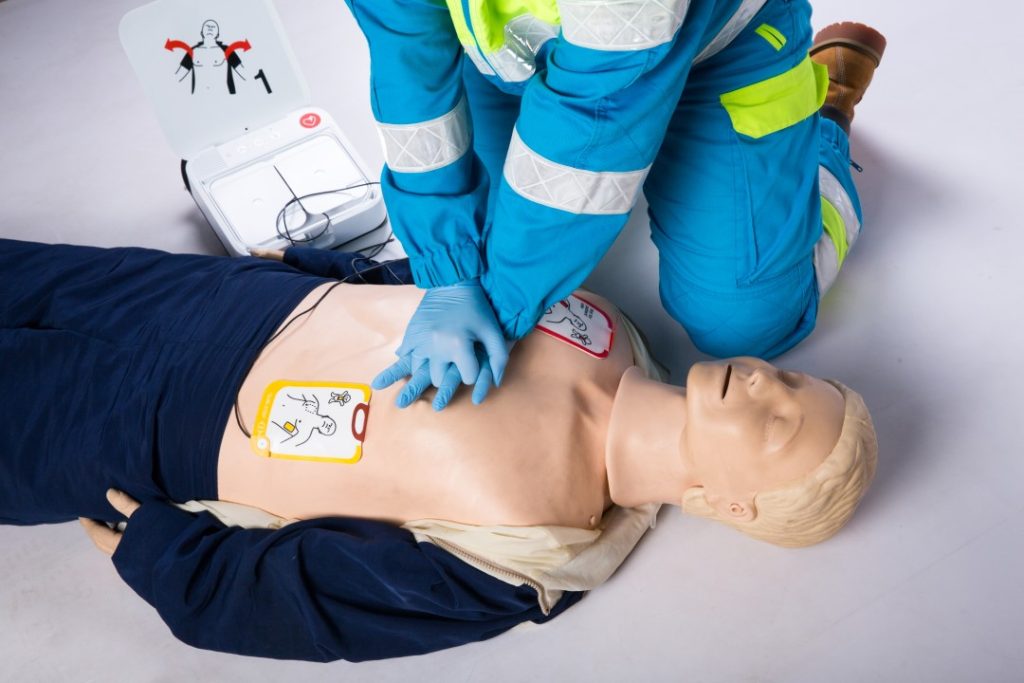When someone collapses and stops breathing normally, every second counts. Hands-Only CPR empowers everyday people to take immediate action that can double or even triple a victim’s chance of survival. This guide will walk you through this lifesaving technique, explain when to use it, and provide the confidence you need to act decisively in an emergency.
Understanding Hands-Only CPR: The Basics
Hands-Only CPR represents a simplified approach to cardiopulmonary resuscitation that focuses exclusively on chest compressions without rescue breaths. The American Heart Association recommends this technique for untrained bystanders witnessing an adult’s sudden collapse. This streamlined method makes it easier for the public to remember and perform CPR when someone experiences cardiac arrest.
Cardiac arrest strikes without warning—approximately 350,000 out-of-hospital cardiac arrests occur annually in the United States. When the heart stops pumping effectively, blood stops circulating, depriving the brain and other vital organs of oxygen. Brain damage begins within minutes, making immediate intervention crucial.
The beauty of Hands-Only CPR lies in its simplicity: just two steps can help save a life.
The Two Critical Steps of Hands-Only CPR
When you witness an adult suddenly collapse, follow these two straightforward steps:
- Call 911 immediately or direct someone specific to make the call. Clearly state your location and the emergency.
- Begin chest compressions right away. Push hard and fast in the center of the chest, at a rate of 100-120 compressions per minute.
These two actions form the foundation of Hands-Only CPR, making it accessible to anyone regardless of training level or experience.
When to Perform Hands-Only CPR
Knowing when to initiate Hands-Only CPR can make the difference between life and death. Begin this technique when:
- An adult suddenly collapses
- The person is unresponsive (doesn’t answer when you tap them and ask if they’re okay)
- The person isn’t breathing or is only gasping occasionally
Hands-Only CPR works most effectively for adults who experience sudden cardiac arrest. The technique proves particularly valuable in situations where the collapse was witnessed and medical help hasn’t yet arrived.
Proper Technique for Effective Hands-Only CPR
Performing Hands-Only CPR correctly maximizes its effectiveness. Follow these specific steps:
- Position the victim: Ensure they’re lying on their back on a firm, flat surface.
- Position yourself: Kneel beside the victim’s chest, with your knees approximately shoulder-width apart for stability.
- Hand placement: Place the heel of one hand on the center of the victim’s chest (on the lower half of the breastbone). Place your other hand on top of the first hand and interlock your fingers.
- Body positioning: Position your shoulders directly above your hands, keeping your arms straight and locked at the elbows.
- Compression technique: Using your upper body weight, push straight down on the chest about 2 inches (5 centimeters). Allow the chest to completely recoil between compressions.
- Compression rate: Maintain a steady rhythm of 100-120 compressions per minute. The beat of songs like “Stayin’ Alive” by the Bee Gees or “Baby Shark” can help you maintain the proper pace.
- Continue compressions: Don’t stop until emergency medical services arrive, someone with more advanced training takes over, an AED becomes available, or the victim shows obvious signs of life.
The Science Behind Hands-Only CPR
Understanding why Hands-Only CPR works enhances your confidence in performing this life-saving technique. When cardiac arrest occurs, the heart stops effectively pumping blood. Manual chest compressions physically squeeze the heart between the breastbone and spine, artificially circulating oxygen-rich blood that remains in the system.
For the first few minutes after cardiac arrest, blood oxygen levels remain relatively high. By focusing solely on compressions, you maintain the circulation of this oxygen-containing blood to vital organs, particularly the brain. This circulation dramatically increases survival chances until professional help arrives.
Research shows Hands-Only CPR produces outcomes similar to conventional CPR with rescue breaths when performed on adult victims of sudden cardiac arrest. The American Heart Association endorses this technique because:
- It’s easier to learn and remember
- It eliminates hesitation related to mouth-to-mouth contact
- It allows for continuous chest compressions without interruption
Common Concerns About Performing Hands-Only CPR
Many bystanders hesitate to perform CPR due to various concerns. Let’s address the most common ones:
“I’m afraid I’ll hurt the person.”
While chest compressions may cause rib fractures, particularly in older adults, this risk is acceptable compared to the certainty of death without intervention. Remember the saying among medical professionals: “It’s better to break ribs than to break a family.”
“I’m worried about legal liability.”
All 50 states have Good Samaritan laws protecting bystanders who attempt to help in an emergency. These laws shield you from legal liability when providing reasonable assistance.
“I’m concerned about disease transmission.”
Hands-Only CPR eliminates mouth-to-mouth contact, significantly reducing infection risk. The chance of contracting a serious disease while performing Hands-Only CPR is extremely low.
“I don’t feel confident in my ability.”
Any CPR is better than no CPR. Even imperfect compressions significantly improve survival chances compared to doing nothing while waiting for emergency services.
Hands-Only CPR vs. Conventional CPR: When to Use Each
While Hands-Only CPR works well in most adult cardiac arrest scenarios, conventional CPR (combining chest compressions with rescue breaths) remains important in specific situations:
- For children under 8 years old
- For drowning victims
- For people found unconscious (not witnessed collapsing)
- For victims of drug overdose
- When cardiac arrest results from breathing problems
In these cases, both oxygen circulation and fresh oxygen delivery through rescue breaths become crucial. However, if you’re untrained or uncomfortable with rescue breaths, Hands-Only CPR remains better than no intervention.
Hands-Only CPR and Automated External Defibrillators (AEDs)
The effectiveness of Hands-Only CPR increases dramatically when combined with an Automated External Defibrillator (AED). These devices, increasingly available in public spaces, analyze heart rhythm and deliver an electric shock if needed to restore normal heart function.
If an AED becomes available while you’re performing Hands-Only CPR:
- Turn on the AED and follow its voice prompts
- Attach the electrode pads to the victim’s bare chest as shown in the diagrams
- Allow the AED to analyze the heart rhythm (stop compressions during analysis)
- If advised, ensure no one is touching the victim and press the shock button
- Resume Hands-Only CPR immediately after the shock until the AED prompts you to pause again
The combination of early Hands-Only CPR and rapid defibrillation offers the best chance for survival from sudden cardiac arrest.
Teaching Others About Hands-Only CPR
Spreading knowledge about Hands-Only CPR multiplies its life-saving potential. Consider sharing these key points with family, friends, and colleagues:
- The two simple steps: Call 911 and push hard and fast in the center of the chest
- The importance of immediate action
- The fact that any attempt at CPR is better than none
- The protection provided by Good Samaritan laws
By educating those around you, you extend the network of potential lifesavers in your community.
Preparing for Emergencies Beyond Hands-Only CPR
While Hands-Only CPR provides a critical first response, comprehensive preparation for cardiac emergencies involves additional steps:
- Learn to recognize the warning signs of sudden cardiac arrest: sudden collapse, absence of response, and abnormal or absent breathing
- Familiarize yourself with AED locations in places you frequently visit
- Save emergency contact numbers in your phone for quick access
- Consider downloading CPR timer apps that help maintain the proper compression rate
- Take a formal CPR certification course for more comprehensive training
These preparations complement your Hands-Only CPR knowledge, creating a more robust emergency response capability.
The Chain of Survival: Your Role in the Bigger Picture
Hands-Only CPR forms one crucial link in what medical professionals call the “Chain of Survival”—a series of actions that, when performed quickly and effectively, maximize the chances of survival from cardiac arrest:
- Early recognition and activation of emergency response
- Early CPR with emphasis on chest compressions
- Rapid defibrillation
- Advanced life support and post-cardiac arrest care
As a bystander performing Hands-Only CPR, you provide the vital second link in this chain, keeping the victim alive until more advanced care becomes available. Without your intervention, the chain breaks, significantly reducing survival chances.
Take Action: Get Certified in CPR Today
While Hands-Only CPR provides a valuable emergency skill, comprehensive CPR certification equips you with deeper knowledge and confidence to handle various emergencies. CPR Cincinnati, an American Heart Association training site, offers stress-free, hands-on courses for both initial certification and renewal.
Their expert instructors provide training in:
- Basic Life Support (BLS) for Healthcare Providers
- Advanced Cardiac Life Support (ACLS)
- Pediatric Advanced Life Support (PALS)
- CPR and First Aid
Don’t wait for an emergency to wish you were better prepared. Schedule your CPR certification Cincinnati or BLS certification Cincinnati course today with CPR Cincinnati. Their hands-on approach ensures you’ll gain practical skills in a supportive environment, making you ready to act decisively when seconds count.
Remember: The best time to learn CPR is before you need it. Contact CPR Cincinnati—recognized as the Best CPR in Cincinnati—and take the first step toward becoming a confident, capable lifesaver in your community.





